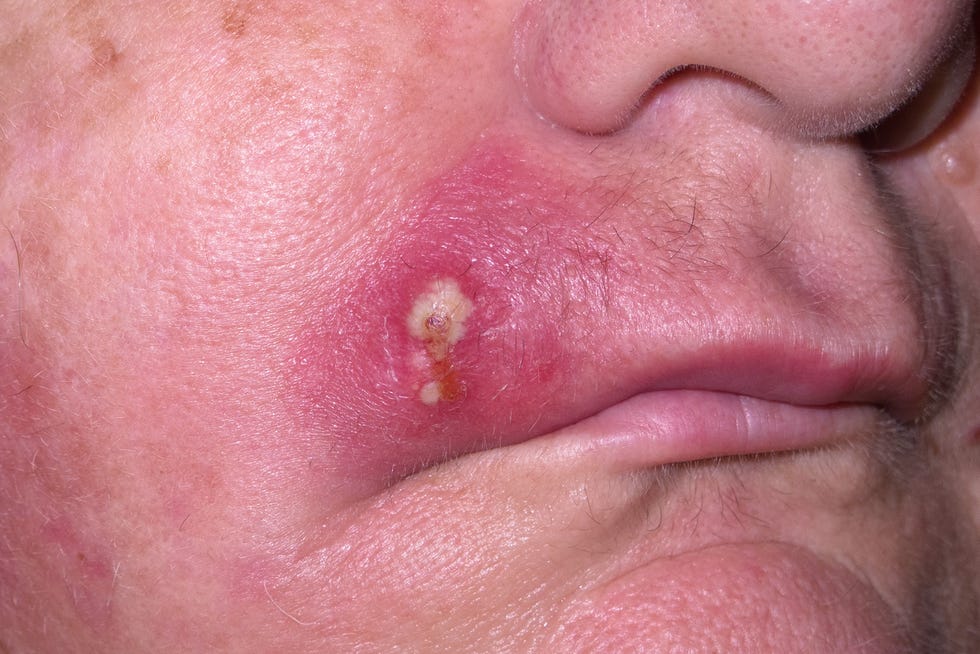Any kind of infection can sound scary at first, but it’s important to understand what’s going on with you and your body so that you can get the help you need. Staph infections, given how common they are, can particularly trigger panic if you aren’t sure what to attribute your symptoms to. Here, we’ve consulted both dermatologists and infectious disease experts to explain exactly what staph infection symptoms you should look for if you suspect something’s wrong.
What is a staph infection?
Put simply, a staph infection is caused by a specific type of bacteria, typically Staphylococcus aureus, though other strains can also cause infection, says William B. Miller, Jr. M.D., infectious disease expert, evolutionary biologist, and author of Bioverse: How the Cellular World Contains the Secrets to Life’s Biggest Questions. “Staphylococcus bacteria are very widely distributed on nearly all surfaces and some staph normally live on our skin.” Staph infections are extremely common, estimated at over one million cases annually in the United States, he adds. “Most are mild and do not need treatment.”
Staphylococcus is a group of bacteria and there are more than 30 different types, per the U.S. National Library of Medicine. They are known as “commensal” microorganisms because they’re friendly enough to live on our bodies without causing any problems, says Paul Fey, Ph.D., medical director of the University of Nebraska Medical Center’s department of pathology and microbiology. “You can find staph in your nose, on your skin, and sometimes in other mucous membranes like your anus,” he explains.
Types of staph infections
While staph bacteria are courteous houseguests when confined to their normal quarters, they can cause infections and illness (most commonly caused by Staphylococcus aureus) if they gain access to areas of your body where they don’t belong. There are different types of staph infections, Dr. Fey says, and they show up in different ways.
“Staph infections most commonly develop when there is a break in the skin, giving the staph an entry point for infection,” explains Joshua Zeichner, M.D., director of cosmetic and clinical research in dermatology at Mount Sinai Hospital in New York City. “This may occur after regular cuts and scrapes, nicks from shaving, or even open skin because of athlete’s foot.”
In addition to minor local infections, staph can also cause a serious immune system reaction to an infection known as sepsis, says Gary Goldenberg, M.D., assistant clinical professor of dermatology at the Icahn School of Medicine at Mount Sinai Hospital. “People can die from a staph infection if it gets into the bloodstream or infects internal organs,” he says.
Who is at risk for staph infections?
Anyone can get a staph infection, says Dr. Miller. “Some people carry staph bacteria that are harmless to them but can cause symptomatic infection in others which can be spread by person-to-person contact.” In other cases, there are identifiable underlying risk factors.
In particular, individuals who are immunosuppressed because of chronic diseases (e.g. types of diabetes, HIV), cancer treatment, or recently post-operative, are more susceptible. Anyone with a heart valve, indwelling catheter, or artificial joint is at higher risk. Drug use is specifically associated with a higher risk for staph infections. Staphylococcus infections can also be spread through improper food handling, leading to food poisoning.
Most staph infections, especially those that involve the skin, are transmitted by skin-to-skin contact, adds Richard Watkins, M.D., infectious diseases physician and a professor of medicine at the Northeast Ohio Medical University. Because staph infections are typically transmitted through close contact, incarcerated people and athletes also have higher risk, he says.
Signs and symptoms of a staph infection
Not sure what to watch for? Here are the telltale signs of a staph infection you should know how to recognize.
1. Skin boils or pustules
Pus-filled or inflamed skin blemishes are by far the most common type of staph infection, Dr. Fey says.
“Let’s say you have a mosquito bite on your arm, and you have staph on your finger because you’ve been scratching or touching your nose,” he says. If you scratch your bug bite or some other place where your skin is broken, the staph bacteria on your finger can infect that wound and cause a big, red, painful, pus-filled blemish to form. You could also develop a rash-like cluster of raised blisters called impetigo, he says.
“It’s fairly common in the ER for people to come in thinking they have a large spider bite, when really they have a staph infection,” Dr. Fey says.
2. Skin infections
Staph is actually the most common cause of cellulitis, a common and potentially serious bacterial skin infection, Dr. Goldenberg says. “It can occur in completely healthy people or in those with weak immune systems,” he says.
Staph usually enters the skin through a cut or eczema patch and causes a local infection, leading to skin inflammation, Dr. Goldenberg explains. This can present as a warm, red, swollen area of skin that is tender or painful to the touch, most commonly on the lower legs, face, or arms.
While it may seem like no big deal, any skin condition that feels unusually painful or irritated should be evaluated by your doctor ASAP, as cellulitis can progress rapidly. “Deep infections like boils or infections of the legs should get immediate attention,” says Dr. Zeichner.
3. Food poisoning
When a food is exposed to staph, the bacteria multiply and produce toxins. It’s those toxins that can make you sick, and they can lead to symptoms like vomiting, diarrhea, and stomach pain, typically within 30 minutes to 8 hours after ingesting the contaminated food, according to the Centers for Disease Control and Prevention (CDC). However, it’s important to note that a fever is not typically something you’d experience from staph-related food poisoning, Dr. Fey says.
The best ways to avoid staph-related food poisoning is to make sure your food is handled at the right temperature, the CDC says. Hot foods should be kept at 140°F or hotter and cold foods at 40°F or colder. And, of course, it doesn’t hurt to wash your hands thoroughly for at least 20 seconds with soap before cooking or eating.
4. Fever and low blood pressure
In some cases—usually when someone’s exposed to staph in a hospital setting, like during surgery—staph bacteria can get into your bloodstream, Dr. Fey says.
This can cause a blood infection known as bacteremia, which can initially lead to a fever and low blood pressure. Once in your blood, this kind of staph infection can spread to your heart, bones, and other organs—and result in a number of serious or even deadly infections. Those include pneumonia, and also a type of bone infection called osteomyelitis, which could lead to swelling or warmth in the infected area, according to resources from the Mayo Clinic.
Bacteremia could also lead to an infection of the lining of your heart known as endocarditis. Symptoms—like fever, chills, night sweats, joint pain, pale skin, and weakness—can develop very slowly, suddenly, or even come and go, per the U.S. National Library of Medicine.
5. Toxic shock syndrome
When the toxins staph produces accumulate, they can cause a particular type of blood poisoning known as toxic shock syndrome (TSS). This could lead to a sudden fever, vomiting or diarrhea, muscles aches, headaches, and a rash resembling sunburn on your palms and the soles of your feet, research shows.
TSS is rare, though. The condition affects fewer than one in 100,000 people in the U.S., according to data from the CDC.
6. Sepsis
If a staph skin infection is left untreated, it can eventually enter the bloodstream and lead to sepsis, Dr. Goldenberg says, which is an intense immune system reaction to an infection that sends harmful inflammatory chemicals into the blood and other internal organs. This can block proper blood flow and potentially cause your organs to shut down, which can be fatal. Someone with sepsis might have one or more of the following symptoms, according to the CDC:
- A high heart rate
- Fever, shivering, or feeling very cold
- Confusion or disorientation
- Shortness of breath
- Extreme pain or discomfort
- Clammy or sweaty skin
How is a staph infection diagnosed?
Simple infections can be diagnosed clinically, says David Cennimo, M.D., assistant professor of medicine-pediatrics infectious disease at Rutgers New Jersey Medical School. “Often, you want to drain a collection, meaning drain the pus of any boils and send it to the lab, and see what bacteria is there.” He adds that if the staph infection has traveled to the bloodstream, your doctor will likely take blood samples to grow a blood culture to determine if the infection is indeed caused by staph bacteria.
How is a staph infection treated?
There are several antibiotics that treat staph infections, both oral and intravenous ones, says Dr. Watkins. “Usually, the person is no longer contagious once the symptoms are resolved.” However, some people become carriers of staph and can pass it on even when they don’t have symptoms of active infection.
Depending on the resistance, some staph infections are pretty sensitive to most antibiotics and some have more resistance, says Dr. Cennimo. He says that the usual course for treatment can “anywhere between a week and 6 weeks of antibiotics.”
What is MRSA?
You’ve probably heard of MRSA—pronounced “mer-sa”—which stands for “methicillin-resistant Staphylococcus aureus,” Dr. Fey explains. As the name states, this is a type of staph that has developed resistance to certain antibiotic drugs, including a commonly used type called methicillin.
In most cases, MRSA infections manifest just the same as other types of staph infections—meaning they show up as skin boils or pustules, he says. But MRSA can also lead to some of the more serious skin and blood infections mentioned above. In those cases, MRSA’s drug resistance may make it tougher to treat.
That’s why “staph infections need to be treated immediately,” Dr. Goldenberg says, which could range anywhere from topical or oral antibiotics for superficial skin infections to IV antibiotics for more serious infections.
While anyone can develop a staph infection, those with weakened immune systems and diabetes are at a higher risk, Dr. Goldenberg says. People with eczema also tend to get more superficial staph infections, he says.
How to prevent a staph infection
Washing your hands thoroughly and often—especially when you’ll be handling food or touching a wound or broken skin—is the best way to prevent a staph infection, Dr. Fey says.
You should also try to keep broken skin (such as itchy rashes, cuts, and sores) away from gym equipment and other surfaces that may be harboring bacteria. “Make sure you tend to any open skin by cleaning the area, applying over-the-counter antibiotic ointment and then cover with a bandage to protect the area,” Dr. Zeichner says. “Do not share personal care products like razors, as they can spread bacteria, and avoid direct contact of the skin with someone who has crusts, scabs, or signs of an active infection themselves.”
If you have eczema, make sure it’s treated and see a doctor if you have any uncontrolled or infected-looking flare-ups, Dr. Goldenberg adds.
While you may be tempted to give yourself an intense scrubbing in the shower to optimize your hygiene, Dr. Cennimo advises against it. “Don’t dry out your skin (or scrub too hard in the shower) because if you have dry cracked skin, bacteria can hide in those cracks.” So after your shower or following any kind of exfoliation, be sure to moisturize!
And lastly, whenever you’re engaging in healthcare, make sure that everybody that is seeing you is washing their hands, says Dr. Cennimo. “It’s ok to ask ‘did you wash your hands?’ and alcohol hand sanitizers can do just as well.”
When to see a doctor about staph infection symptoms
Anybody that is having high fever or signs of systemic infection (fever, chills, change in activity level) should seek urgent medical care, says Dr. Cennimo. “Things that look like a skin infection that are lasting more than a day that are expanding rapidly, that are making you have a fever, that are particularly painful, you really need to be evaluated.”
Also, if someone you have had contact with has a staph infection and you have new symptoms on your skin, seeing a doctor would be a good idea, adds Dr. Watkins.
Unless you have an angry skin boil or blemish, spotting a staph infection is going to be difficult, since the symptoms can overlap with all sorts of health conditions, Dr. Fey says. When in doubt, see your doctor, who can give you a proper diagnosis and treatment plan.
..Markham Heid is an experienced health reporter and writer, has contributed to outlets like TIME, Men’s Health, and Everyday Health, and has received reporting awards from the Society of Professional Journalists and the Maryland, Delaware, and D.C. Press Association.
Madeleine, Prevention’s assistant editor, has a history with health writing from her experience as an editorial assistant at WebMD, and from her personal research at university. She graduated from the University of Michigan with a degree in biopsychology, cognition, and neuroscience—and she helps strategize for success across Prevention’s social media platforms.














